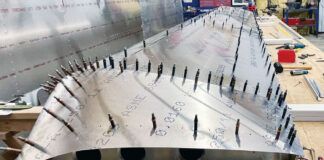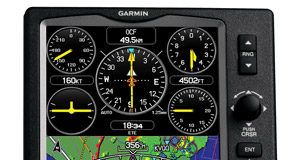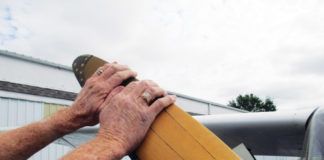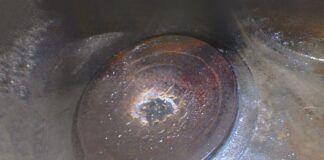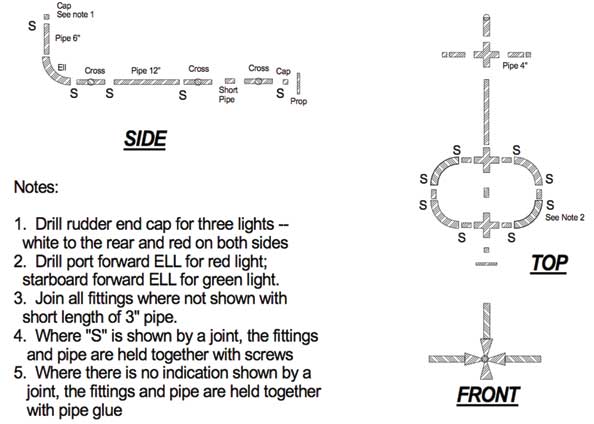
In October 2004, SpaceShipOne took a serious suborbital tour, the first manned civilian outer space flight. Good heavens, could that have been nearly six years ago already?
At any rate, I had written a series of articles on Back Yard I, my relatively sophisticated backyard wind indicator, in the July, August and September 2005 issues of KITPLANES. This was a wind indicator on steroids, complete with a solar charger, navigation lights and a flashing beacon.
At the time, I said there were a few things I could have done better. First, putting a wood structure out in the weather and not expecting annual maintenance was just wrong. Second, I knew that the batteries had a lifetime measured in fractions of dozens of years, but getting to them for replacement was not easy. Third, the propeller I put on the front required a fairly stiff breeze to make it go; it was an RC model airplane propeller that was optimized for 10,000 rpm, not a 2-mph zephyr.
So lets do the Back Yard II wind tee. And with the wisdom gained from the first experimental version, lets figure out how to overcome the limitations of that original design.
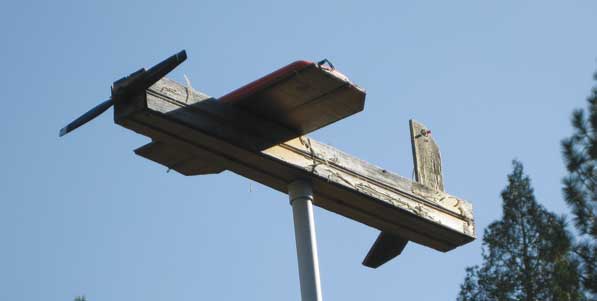
Back Yard I after five years without maintenance. Snow has taken off the port horizontal stabilizer, and the starboard stabilizer isn’t looking all that great.
Lets Talk Structure
Wood is nice, but it is subject to everything we know about rot, splitting, peeling and other stuff that snow, rain and baking sunshine do to wood (did I get that right, Pietenpolers?). Whats the alternative? I think Rutan answered that one quite nicely. Plastic. And what is the least expensive form of plastic available to the average electronic homebuilder? Irrigation pipe.
The problem with regular irrigation pipe is that it is somewhat heavy in the larger sizes. My answer to that is that there is one type of irrigation pipe that isn’t all that heavy: styrene. Not PVC, styrene. The problem with styrene is that it is about twice as expensive as PVC, but you get what you pay for. For example, in 3-inch styrene the X crosses Im using for wing and horizontal stabilizer fabrication are about $20 a pop, while in PVC they are a bit less than $10 apiece. Why worry about weight? Because in this sort of device, a pivot for the wind tee is nothing more than a carriage bolt onto a pipe cap, and the less weight you put on that pivot, the easier it will turn.
You might wonder why Im making it out of so large a pipe. Because I want to be able to pull the innards (i.e., the charging circuit and batteries) out of the machine for repair. I know that the electronics will probably last for the lifetime of the author, but the batteries have a definite charge-discharge cycle lifetime. And that charge-discharge cycle occurs 365 times a year. The only way I could figure out how to do that to have a threaded engine on the design so that I could unscrew the front end (engine and propeller) and pull the electronics out through the front hole.
The Propeller
Serendipity often has a way of making things work like magic. A friend of mine needed a ride over to the local RV fix-it shop to pick up his land yacht. While waiting around for him, I was looking over the motor home replacement part shelves (you think airplane parts are expensive…). What do I see but a multi-blade propeller made from plastic. I asked the fellow what it was, and he said it was a low-speed fan blade for a potty exhaust fan-exactly what I needed for a low-velocity wind propeller. At $5, its probably the cheapest part of the airplane.
However, there is a problem, and it goes like this. Up front on this plane we have a heavy threaded propeller fitting, a heavy set of crosses for the wing and a heavy solar panel. Can you say forward CG? Sigh. I don’t want to make this thing any heavier with all the electronics and the battery up front, either. So some rethinking of the design was required.
Instead of threaded, how about we use what would normally be a glued together slip (as opposed to threaded) fitting joint, but instead of glue we can use small brass wood screws to hold the fitting to the pipe. That way, you can take off both the front and back sections of the airplane, leaving a straight through-hole of the fuselage.
Yes, Im going to paint it. Not as much for protection as for aesthetics. It is one thing to make a backyard feature out of water pipe, and it is another to leave it looking like water pipe when you are done. Most of you who have followed my articles have at one time or another seen the classic blue-on-blue 182A Snarly Charlie with N-number N 73 CQ. Those of you who are hams and who have been around since we had to know Morse Code know that 73 is best wishes and CQ (seek you) was the call to see if any-body wanted to chat.
More foolishness. This Back Yard II has been christened N 88 YF, 88 being the Morse code for love and kisses and YF being the abbreviation for wife.
Now to the lighting. It doesn’t bother me to put the lighting in a place where it may be somewhat difficult to replace the bulb, as long as I can replace the bulb if it ever burns out. Using LED lamps with a theoretically infinite lifetime helps, but nature (in the form of lightning) can hand you a nasty surprise from time to time.
We will deal with our nav lights the same way we dealt with opening up the fuselage to take the batteries and circuit boards in and out. Wherever we mount a lamp, well attach the plastic fittings in such a way as to afford access to the area in question. How to hold the bulbs in? Easy. Drill a hole the same size as the bulb case, press the bulb into the hole, and RTV it from the backside.
Run two wires from each bulb down into the fuselage and leave enough extra wire so that no matter where we wind up mounting our circuit board, we can wire the bulbs to it. I don’t think I need to tell you not to rats nest the wires; twist them together, color-code them, and make it look neat and tidy inside.
Thats it for now. Im going to continue refining this project and promise that Ill return to it in the July issue-skipping a month. Stay tuned.










